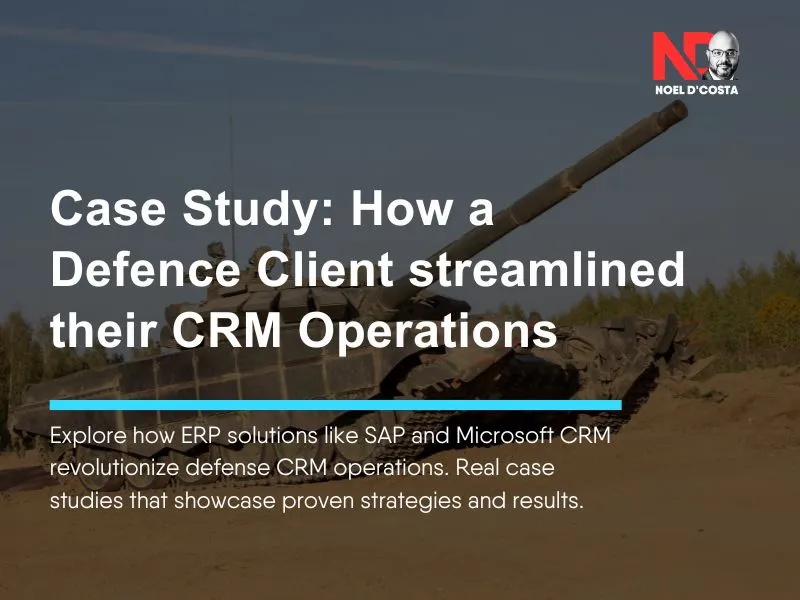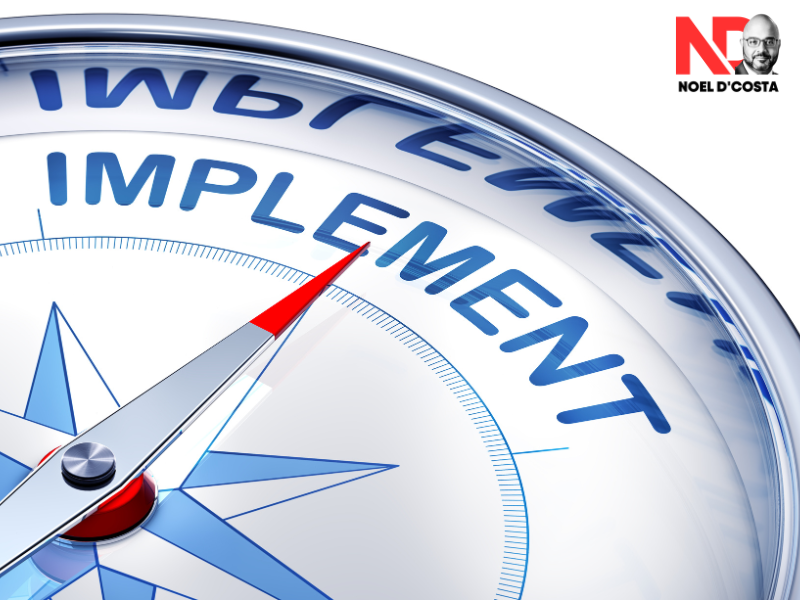Change Management Plan: Fix Resistance Before It Starts

NOEL BENJAMIN D'COSTA
I hope you enjoy reading this blog post. If you need any advise, please do not hesitate to reach out by clicking here
Taking on an SAP implementation can feel overwhelming, especially when it comes to managing how people adapt to the changes. Questions like, “What does this mean for me?” or “How do I fit into this new system?” are common, and without clear communication, confusion can quickly turn into frustration.
From my experience as an SAP ERP consultant, I’ve seen how a solid change management plan can turn potential chaos into a smooth transition.
Think of it as a guide that helps everyone understand what’s happening, why it’s happening, and how they’re involved.
It’s not just about sending emails or holding meetings—it’s about having a real plan that answers key questions, sets clear expectations, and keeps everyone aligned.
When you communicate clearly, keep updates regular, and provide spaces for feedback, people feel supported and ready to embrace the change. It’s not magic; it’s about connecting the dots for everyone involved so they know their role in making the project a success.
If you’ve ever struggled to get everyone on the same page during a project, the right change management plan can make all the difference. Let’s dive into how you can build one that works.

Key Takeaways
Implementing a Change Management Plan is crucial for the success of any SAP project. Here are six key takeaways:
- Clear Communication: Establish open channels to inform all stakeholders about upcoming changes, reducing uncertainty and resistance.
- Stakeholder Engagement: Involve key stakeholders early to gain their support and address concerns promptly.
- Comprehensive Training: Provide thorough training to ensure users are comfortable and proficient with new systems and processes.
- Resource Allocation: Allocate necessary resources, including time and personnel, to manage the change effectively.
- Continuous Monitoring: Regularly assess the progress of the change initiative to identify and address issues swiftly.
- Leadership Support: Ensure leadership is visibly committed to the change, providing direction and motivation to the entire organization.
Implementing these strategies can lead to a smoother transition and higher success rates in SAP projects.
Importance of Change Management Communication
When implementing SAP, clear communication can be the difference between a smooth rollout and a rocky road. Change brings uncertainty, and if people aren’t sure what’s happening or how it affects them, confusion can quickly take over. That’s where effective change management communication steps in to bridge the gap.
Timely communication helps everyone understand the what, why, and how. What’s changing? Why is it necessary? How will it impact their roles?
According to Your Thought Partner, these are the core questions a good communication plan answers. It helps stakeholders see the bigger picture, understand their responsibilities, and feel more confident about the process ahead.
But it doesn’t stop there. Communication isn’t just about sending out information—it’s about listening too. A robust plan creates opportunities for feedback, ensuring that everyone’s concerns are heard and addressed.
Leaders play a key role here, setting the tone and guiding their teams to adapt to new behaviors, as highlighted in the SAP Learning Journey.
Training change agents as communicators can also make a big impact. These individuals become the voice of the project within their teams, ensuring that the right messages are delivered to the right people at the right time.
When communication is clear and consistent, it builds trust, reduces resistance, and keeps your SAP project on track.

Developing an Effective Change Management Communication Plan
Creating a successful change management communication plan starts with understanding the organization, its people, and how they’ll be affected by the SAP implementation. A well-thought-out plan not only supports business objectives but also helps everyone adapt more smoothly to the changes. Here’s a step-by-step guide to crafting a communication plan that works:
Assess the Change Impact: Identify how the SAP implementation will impact different stakeholder groups. Use tools like surveys or interviews to understand their concerns and expectations.
Identify Key Stakeholders: List everyone affected by the change, from business owners and CFOs to IT teams and end-users. Stakeholder mapping is a great tool for this step.
Develop Communication Messages: Create clear, straightforward messages explaining the change, its impact, and what’s expected from stakeholders. Message templates and scripting can help streamline this process.
Choose Communication Channels: Select the most effective ways to share information, such as emails, meetings, or intranet updates.
Establish Feedback Mechanisms: Set up ways for stakeholders to ask questions and share feedback, like feedback forms or Q&A sessions.
Assign Communicators: Identify leaders or change agents who will take responsibility for delivering key messages. Leadership training can prepare them for this role.
Implement the Communication Plan: Roll out the plan according to a clear timeline, using the chosen tools and channels.
Evaluate Effectiveness: Continuously assess how well the plan is working by collecting feedback from leaders, change agents, and cross-functional teams.
Summary Table
| Step | Description | Tools/Channels |
|---|---|---|
| Assess Change Impact | Understand effects on stakeholders | Surveys, Interviews |
| Identify Key Stakeholders | List all impacted individuals/groups | Stakeholder Mapping |
| Develop Communication Messages | Craft clear and concise messages | Message Templates, Scripting |
| Choose Communication Channels | Determine the best channels for delivery | Emails, Meetings, Intranet |
| Establish Feedback Mechanisms | Provide avenues for feedback and questions | Feedback Forms, Q&A Sessions |
| Assign Communicators | Identify responsible leaders and change agents | Leadership Meetings, Training |
| Implement Communication Plan | Execute the plan with a clear timeline | Project Timelines, Communication Schedules |
| Evaluate Effectiveness | Continuously assess and adapt | Surveys, Feedback from Teams |
Produced by Noel D'Costa
Implementing SAP with a Strategic Change Management Approach
When you’re starting an SAP implementation, it can feel overwhelming—I’ve been there. But with a clear plan in place, you can take control and guide your team through the process. One of the best SAP Implementation strategies I’ve used in my projects is based on the SAP Activate methodology. It breaks the implementation into simple, structured steps, so you always know what’s next.
Here’s how I approach it using SAP Activate:
SAP Activate Phases
| Phase | Key Activities | Deliverables |
|---|---|---|
| Discover | Identify business goals, Assess readiness, Explore SAP solutions | Business case, High-level roadmap |
| Prepare | Project planning, Define governance, Set up project team | Project charter, Initial system setup |
| Explore | Fit-to-Standard workshops, Validate requirements, Identify gaps | Solution validation, Requirement documentation |
| Realize | System configuration, Custom development, Data migration | Configured system, Integration test results |
| Deploy | End-user training, Final data migration, Go-live preparation | Go-live checklist, Deployment strategy |
| Run | Continuous monitoring, Ongoing support, Optimization | Performance reports, Enhancement roadmaps |
Produced by Noel D'Costa | Visit my website
The way I see it, each of these phases is a chance to connect with your team, address their concerns, and keep the project moving forward. SAP Activate makes it easier to manage the technical side, but success really comes from making sure your team feels ready and supported.
I’ve used this approach with clients in different industries, and it works because it’s structured but flexible. If you’re wondering how to tailor it to your organization, check out the SAP Activate Learning Hub. Together, we can make your SAP implementation a success!
SAP Activate Phases
| Phase | Key Activities | Deliverables | Business Benefits |
|---|---|---|---|
| Discover |
|
|
|
| Prepare |
|
|
|
| Explore |
|
|
|
| Realize |
|
|
|
| Deploy |
|
|
|
| Run |
|
|
|

Why SAP Implementation Requires Careful Planning
Let’s talk about SAP implementation—it’s not something you just plug in and start using. It requires careful planning and customization to meet your organization’s unique needs. Over the years, I’ve seen that success comes from aligning the system with your business processes and ensuring the technical setup is solid. It’s all about creating a tailored solution that fits how your company works.
Here’s how I typically break down an SAP implementation project:
SAP Project Implementation Steps
| Step | Key Activities | Deliverables | Tools & Resources |
|---|---|---|---|
| Project Preparation |
|
|
|
| Business Blueprint |
|
|
|
| Realization |
|
|
|
| Final Preparation |
|
|
|
| Go-Live & Support |
|
|
|
Produced by Noel D'Costa | Visit my website
Each of these steps requires attention to detail and collaboration with your team.
From defining your goals in the Project Preparation phase to ensuring everything runs smoothly in Go-Live, every stage builds on the one before it.
I always tell clients, “The time you invest in planning and preparation is what sets you up for success.” If you’re curious about how to approach this systematically, check out how to create an SAP implementation project charter. Together, we can make your SAP implementation as smooth and effective as possible!
Overcoming Challenges in SAP Implementation with a Change Management Plan
SAP implementation offers significant benefits, but it also comes with its fair share of challenges. From resource constraints to tight timelines, these obstacles can derail a project without proper planning. Over the years, I’ve seen how having a well-structured change management plan can help tackle these hurdles effectively.
Here are some common challenges and how a change management plan helps address them:
SAP Project Change Management Challenges
| Change Management Challenge | Impact on SAP Projects | Mitigation Strategies | Business Benefits |
|---|---|---|---|
| Resistance to Change |
|
|
|
| Poor Communication |
|
|
|
| Unclear Business Requirements |
|
|
|
| Customization Overload |
|
|
|
| Data Migration Challenges |
|
|
|
| Inadequate Training |
|
|
|
A strong change management plan bridges the gap between technical implementation and team readiness. It brings clarity to resource allocation, sets realistic expectations for testing and configuration, and ensures that timelines and budgets remain achievable.

Building a Strong Change Management Plan for SAP Implementation
Ensuring a successful SAP implementation isn’t just about following technical steps—it requires a holistic approach that addresses planning, resources, communication, and leadership. Over the years, I’ve learned that paying attention to these critical factors can make all the difference:
SAP Project Critical Success Factors
| Critical Success Factor | Impact on SAP Project | Best Practices | Business Benefits |
|---|---|---|---|
| Strong Executive Sponsorship |
|
|
|
| Clear Business Objectives |
|
|
|
| Effective Change Management |
|
|
|
| Robust Data Governance |
|
|
|
| Agile and Iterative Implementation Approach |
|
|
|
| Comprehensive User Training |
|
|
|
By focusing on these key success factors, you can lay a strong foundation for your SAP project.
Comprehensive planning ensures everyone knows what to expect, while effective resource allocation keeps everything moving. Engaging stakeholders and providing leadership support ensures alignment, and rigorous testing minimizes hiccups. Most importantly, training ensures your team is ready to use the system confidently.
For more tips and tools to guide your project, explore the SAP project quality gates and checkpoints guide. With the right focus, you’ll be set for a successful implementation and long-term benefits.

Change Management Plan Strategies for SAP Implementation
Successful SAP implementation requires a robust change management strategy. Here are my key strategies for ensuring a smooth transition in SAP projects:
1. Building a Change Management Plan for SAP Implementation
A well-defined change management plan is critical for the success of any SAP project. It helps guide everyone through the transformation, ensuring clarity, alignment, and long-term adoption. Here’s a structured breakdown of the process with examples for better understanding:
SAP Change Management Steps
| Step | Key Activities | Deliverables | Tools & Resources |
|---|---|---|---|
| Change Strategy & Planning |
|
|
|
| Engagement & Communication |
|
|
|
| Training & Enablement |
|
|
|
| Adoption & Reinforcement |
|
|
|
| Continuous Improvement |
|
|
|
Produced by Noel D'Costa | Visit my website
Each of these steps builds a structured approach to managing change effectively.
By engaging leaders, stakeholders, and users, while ensuring ongoing communication and training, the organization becomes well-prepared to embrace the new system.
2. The Role of Change Agents in SAP Projects
Let’s face it—implementing SAP isn’t just about installing software; it’s about getting everyone on board with the change. That’s where change agents come in. These are the people within your organization who act as the bridge between the project team and everyone else. They’re trusted, approachable, and know how to rally others when things feel uncertain.
Here’s what makes a great change agent and how they contribute to a smooth SAP implementation:
Key Qualities of Effective Change Leaders
| Quality | Impact on Change Management | Best Practices | Business Benefits |
|---|---|---|---|
| Visionary Thinking |
|
|
|
| Strong Communication Skills |
|
|
|
| Emotional Intelligence |
|
|
|
| Adaptability and Resilience |
|
|
|
| Stakeholder Management |
|
|
|
| Data-Driven Decision Making |
|
|
|
Change agents aren’t just “nice to have”—they’re essential.
They make the change feel less like a top-down directive and more like a team effort. By selecting the right people, you can create a sense of trust and momentum that carries the project through any bumps along the way.
If you’re looking to learn more about how change agents can make a difference in your SAP project, check out Clarkston Consulting. These insights can help you pick the right champions for your change journey.

3. The Role of Leadership in SAP Change Management
Leadership involvement in SAP implementation is crucial for success. Leaders shape the direction of the project, drive change, address challenges, and keep the organization aligned with its goals. In my experience, strong leadership transforms potential roadblocks into opportunities, ensuring a seamless transition rather than a chaotic journey.
Leadership isn’t just about approving the project;
It’s about being present and involved at every stage. When leaders model commitment and enthusiasm, it filters down to the rest of the organization, making change more approachable and achievable.
For more insights into effective leadership in SAP projects, explore Clarkston Consulting. You can also visit our guide on creating an SAP project steering committee for additional tips on structuring leadership roles during implementation.
Communication in an SAP Change Management Plan
1. Communication Plan Development
One of the biggest challenges in SAP implementation is ensuring everyone understands what’s happening and why. Without clear communication, stakeholders may feel overwhelmed, confused, or resistant to change. In my experience as an SAP ERP consultant, I’ve seen how a robust communication plan can transform uncertainty into confidence, keeping everyone aligned and engaged throughout the project.
A solid change management communication plan doesn’t just share information—it builds understanding and support. It helps stakeholders see the purpose of the changes, how it impacts them, and what role they play in the transition. Here’s how to create one:
Define the Change and Vision
Start by clearly outlining what’s changing and why. When I work with clients, I focus on aligning the project goals with the organization’s vision. For example, transitioning to SAP might aim to streamline financial processes, improve data accuracy, or enable faster decision-making.
Stakeholder Analysis
Not everyone engages with SAP the same way. Identify key stakeholder groups—like HR, IT, and finance—and understand their unique concerns and needs. Tailored communication ensures each group feels heard and supported.
Crafting Messages
Clear, concise messaging is essential. Explain the benefits and address concerns. For example, a message to procurement teams might highlight how SAP simplifies vendor management and reduces manual errors.
Selecting Communication Channels
Choose channels that suit your audience, such as emails for updates, workshops for training, and intranet posts for FAQs. Regular updates through the right platforms help maintain transparency and momentum.
Engage Change Agents
Change agents act as internal advocates. I’ve seen success when respected team members champion the change, bridging the gap between leadership and staff.
Timeline and Frequency
Communication isn’t a one-time task. Set a schedule for regular updates to keep the team informed and the project on track.
Feedback Mechanism: A two-way communication flow is vital. Use surveys, Q&A sessions, or team meetings to gather feedback, answer questions, and refine your approach.
Example of Communication Plan Elements
| Step | Action | Responsible Party |
|---|---|---|
| Define Change and Vision | Craft clear messages about project goals | Project Manager |
| Stakeholder Analysis | Identify key stakeholder groups | Change Management Team |
| Crafting Messages | Tailor messages for each stakeholder | Communication Team |
| Selecting Channels | Choose appropriate communication channels | Change Agents |
| Timeline and Frequency | Schedule regular updates | Project Scheduler |
| Feedback Mechanism | Set up surveys and Q&A sessions | HR Department |
Using these steps, you can ensure that communication becomes a tool for connection and clarity rather than confusion. When everyone understands the purpose and value of the change, resistance decreases, and the project runs much smoother.


Get more from your SAP Investment with my Expertise
SAP doesn’t have to be complicated. I help businesses get it right.
- ERP & SAP Solutions – Align SAP with your business goals.
- Process Optimization – Cut costs and improve performance.
- License Negotiation – Secure the right SAP licenses at the best price.
Let’s make your SAP investment work for you. Reach out today.
2. Evaluating Communication Effectiveness in a Change Management Plan
One of the biggest challenges I’ve faced in SAP implementations is ensuring that communication efforts truly connect with stakeholders. It’s easy to assume that a plan is working just because messages are sent, but if people aren’t engaging, you risk confusion, resistance, or even project delays. This is where continuous evaluation comes in—it helps identify what’s working and what needs adjustment.
From my experience, a practical approach to evaluating communication starts with gathering insights from the people involved and then adapting based on their feedback. Here’s how I typically address this:
Gather Feedback
Feedback is the foundation for improvement. Engage leaders, change agents, and teams across departments through surveys, interviews, or focus groups. For instance, when implementing SAP for a logistics company, we used quick surveys after team meetings to gauge whether the updates were clear and relevant.
Monitor Engagement
Numbers tell a story. Track metrics like email open rates, meeting attendance, and workshop participation. When working with a finance team, I noticed that low attendance at training sessions indicated we needed to adjust our timing and delivery format.
Analyze Feedback
Once you have feedback, look for patterns. Are there recurring questions or concerns? For example, during an SAP HR rollout, we found that multiple teams were unclear about how to access new self-service tools. This insight helped us craft targeted FAQs and additional training.
Update the Communication Plan
Effective communication evolves. Use what you’ve learned to adjust your approach, whether it’s adding more in-person sessions or simplifying the language in emails. For a manufacturing client, updating the communication plan to include weekly video updates significantly improved engagement.
Evaluation Metrics Table
| Evaluation Method | Metric | Responsible Party |
|---|---|---|
| Feedback Surveys | Survey Response Rates | HR Department |
| Email Engagement | Open and Click-Through Rates | Communication Team |
| Meeting Attendance | Attendance Records | Meeting Organizer |
| Workshop Participation | Participation Levels | Training Coordinator |
| Follow-Up Interviews | Qualitative Feedback | Change Agents |
By regularly assessing communication, I ensure the project stays on track and everyone feels informed and involved. This approach has helped me resolve misunderstandings early, build trust, and keep stakeholders aligned with project goals.
For more tips on evaluating communication strategies, visit Key Performance Indicators for SAP Implementation Success. With these tools, you can fine-tune your communication efforts and ensure the success of your SAP project.
Ensuring User Adoption in a Change Management Plan
User adoption is a critical component of successful SAP implementation. By focusing on effective training strategies and robust support systems, I can tell you that you will have a smoother transition and maximize the benefits of the new SAP system.
1. Training Strategies for SAP Implementation
One of the biggest hurdles in SAP projects is ensuring users are fully prepared to work with the new system. I’ve seen it time and again—without proper training, even the best technology can fall flat. That’s why SAP Activate places such strong emphasis on user readiness throughout the project lifecycle.
Here’s how I’ve approached training in SAP projects, aligned with the principles of SAP Activate:
Tailored Training for Every Role
During the Explore phase, it’s all about understanding who needs to know what. For instance, the finance team may focus on reporting tools, while supply chain teams learn inventory management processes. This tailored approach ensures every user knows how SAP makes their job easier.
Resource: SAP Activate on SAP Help.
Hands-On Practice
In the Realize phase, hands-on learning builds confidence. I’ve run training sessions where users simulate real-life scenarios like processing vendor payments or creating purchase orders. These sessions make users feel ready before go-live.
Resource: SAP Activate Realize Phase.
E-Learning for Flexibility
Not every team can attend live training. E-learning tools like tutorials and recorded webinars are invaluable, especially during the Prepare and Deploy phases. They let users learn at their own pace and revisit content when needed.
Resource: SAP Learning Hub.
Post-Go-Live Workshops and Webinars
Training doesn’t stop at go-live. In the Deploy phase, I’ve found that post-go-live webinars and Q&A sessions help users iron out challenges as they adjust to the system. It’s an ongoing process, and continuous support makes all the difference.
Resource: SAP Learning Journeys.
Tracking Training Progress
To keep things on track, I measure training effectiveness with metrics like completion rates and user feedback. Here’s a simple example of how that looks:
Training Module Performance
| Training Module | Audience | Completion Rate | Feedback Score |
|---|---|---|---|
| Basic Navigation | All Users | 95% | 4.8 |
| Advanced Features | Key Users | 88% | 4.5 |
| Reporting Tools | Management Team | 90% | 4.7 |
Produced by Noel D'Costa | Visit my website
When metrics like completion rates dip, it signals a need to adjust. For example, a low score in advanced features training might mean adding more practical examples or scheduling follow-up sessions.
Proper training isn’t just an extra step—it’s essential to unlocking the full potential of SAP. By aligning with SAP Activate and focusing on tailored, hands-on strategies, you give your team the tools they need to succeed.
2. Enhancing User Adoption: A Practical Approach to Onboarding and Support

SAP Implementation Best Practices
One of the most significant challenges in any SAP ERP implementation is ensuring that end users fully embrace the system. Many organizations underestimate the importance of onboarding and ongoing support, leading to poor user adoption and unrealized ROI. Without a structured plan for training and engagement, even the most well-executed SAP project can falter.
Drawing from my experience as an SAP ERP consultant, I’ve seen firsthand how a clear onboarding strategy and robust support mechanisms can transform user adoption rates. Here’s a roadmap to tackle this challenge effectively:
Onboarding Sessions: Training shouldn’t be a one-size-fits-all exercise. The change management team must design comprehensive sessions tailored to user roles, covering critical functionalities. These sessions, delivered during the Deploy phase, should follow a clear structure like the SAP Learning Journey.
Dedicated Support Channels: Providing timely assistance is crucial. Establishing 24/7 help desks, creating user-friendly chat options, or assembling a dedicated support team ensures that users always have access to expert guidance.
Regular Check-ins: User needs evolve, and periodic check-ins allow for proactive issue resolution. Monthly feedback sessions help uncover challenges users face and ensure they remain confident with the system.
Continuous Learning Opportunities: SAP systems are dynamic, with new features and updates regularly introduced. Quarterly training sessions keep users informed and comfortable navigating the evolving platform.
To manage and monitor these efforts, tracking tools like the table below can help ensure all aspects of support are covered:
| Support Element | Availability | User Satisfaction | Responsiveness |
|---|---|---|---|
| Onboarding Sessions | Weekly | 4.9 | Immediate |
| Help Desk Support | 24/7 | 4.7 | Within an hour |
| Regular Check-ins | Monthly | 4.8 | Within a day |
| Continuous Learning | Quarterly | 4.6 | Scheduled |
By implementing these structured strategies, organizations can not only improve user adoption but also build user confidence and ensure long-term success.
3. Setting Clear Priorities for SAP Project Success
A successful SAP project begins with a well-structured plan that prioritizes tasks and ensures efficient resource allocation. Without clearly defined priorities, teams risk delays, budget overruns, and an uneven focus on what truly matters. Establishing a hierarchy of tasks, coupled with resource planning, is essential for keeping the project on track and delivering meaningful results.
From my experience in SAP ERP consulting, aligning task importance with business goals and resource availability ensures the project team remains focused on critical deliverables. A comprehensive project plan should address:
Task Prioritization: Break tasks into categories based on their importance to the project’s core objectives. High-priority tasks should focus on system functionalities and critical integrations, while lower-priority tasks can be scheduled for later phases.
Resource Allocation: Assigning in-house personnel to tasks based on their expertise and availability ensures smooth execution. It’s essential to account for personnel workloads and plan for potential bottlenecks in advance.
Timeline and Cost Breakdown: Creating a detailed timeline and cost estimate for each activity prevents scope creep and helps stakeholders stay aligned with project goals.
Sample Task Prioritization Table:
| Task Category | Example Tasks | Priority |
|---|---|---|
| Functional | Core module integration | High |
| Operational | Data migration | High |
| Enhancement | User interface improvements | Medium |
| Maintenance | Minor bug fixes | Low |
Prioritizing tasks in this manner allows project managers to focus resources on high-impact areas, ensuring a smooth transition to SAP. For further insights on effective planning, explore our article on Resource Allocation Planning for SAP Projects.
These strategies, when implemented, help streamline complex SAP projects and ensure each task aligns with the organization’s overall objectives.

4. Test Management in SAP Implementation
Test management is critical in ensuring SAP implementations deliver the expected results without disruptions. Without effective testing strategies, projects can encounter costly delays and performance issues post-go-live. Scheduling capabilities and collaborative tools play a pivotal role in maintaining visibility and control throughout functional, regression, and user acceptance testing (UAT).
Drawing from my experience as an SAP consultant, well-structured testing cycles offer a robust foundation for project success. Here’s a breakdown of key testing phases to prioritize:
Functional Testing: Validates the core functionalities and modules of the system to ensure they meet business requirements. Automated testing tools streamline this phase, reducing manual effort and enhancing accuracy.
Regression Testing: Focuses on maintaining system stability after updates or modifications. Version control tools help identify and address unintended disruptions, safeguarding system integrity.
User Acceptance Testing (UAT): Involves end users to validate that the system meets their needs. Collaborative platforms are essential to gather feedback efficiently and address user concerns before go-live.
Test Management Overview Table:
| Test Type | Focus Area | Tools Needed |
|---|---|---|
| Functional Testing | Core functionality and modules | Automated testing tools |
| Regression Testing | System stability post-changes | Version control tools |
| User Acceptance Testing | End-user approval and feedback | Collaboration platforms |
Real-time visibility into testing cycles ensures proactive management, minimizes risks, and enhances overall project outcomes. For a deeper dive into quality assurance processes, visit our SAP Project Quality Gates and Checkpoints Guide.
Effective test management not only mitigates risks but also builds stakeholder confidence in the system, paving the way for a successful SAP implementation.
5. Standardized Change Management Procedures
Imagine a scenario where an organization implements SAP without a clear change management strategy. Early enthusiasm wanes as teams struggle to keep up with system updates, and stakeholders voice concerns over misaligned processes. Without standardized procedures, even the best implementations risk falling apart due to confusion and miscommunication.
Having a structured change management framework eliminates this chaos. By systematically controlling and monitoring changes, organizations ensure a smooth transition, minimizing resistance and maximizing user adoption. Here’s how to approach it effectively:
Key Practices for Standardized Change Management
Set Up a Change Management Office: A dedicated office streamlines all change-related activities, ensuring consistency across teams and departments.
Leverage Change Management Consulting: Consulting experts provide tailored strategies, offering a neutral perspective to address unique organizational challenges.
Ensure Continuous Training and Post-Go-Live Support: Regular training sessions and accessible support channels empower users to adapt and thrive in the new system.
Critical Success Factors for Managing Change
- Leadership Alignment: Unified leadership sets the tone for the entire project, ensuring clear goals and accountability.
- Active Sponsorship: Visible support from top executives motivates teams and reassures stakeholders.
- Effective Communication: Transparent updates foster trust, reducing resistance and encouraging collaboration.
Example Breakdown of Success Factors:
| Factor | Key Actions |
|---|---|
| Leadership Alignment | Align objectives across departments. |
| Active Sponsorship | Involve executives in change activities. |
| Effective Communication | Maintain transparency through regular updates. |
By integrating task prioritization, meticulous test management, and standardized change procedures, organizations can navigate the complexities of SAP implementations with confidence and clarity. These practices ensure that your project remains on track, meeting both technical and business objectives.
Creating an Effective SAP Change Management Plan...
Change can be daunting, right? Especially during something as complex as an SAP implementation. I’ve been there—facing resistance from teams, dealing with miscommunication, and navigating the chaos of aligning business processes with a new system. That’s exactly why having a solid SAP Change Management Plan is a game-changer.
Here’s what I’ve learned (and I’m sharing it with you):
- Talk the Talk: Clear communication is everything. Tailor your message for different audiences—what resonates with leadership won’t work for the operations team. Simplify technical jargon and keep everyone in the loop.
- Get Everyone Onboard: Stakeholders are key. Whether it’s the finance team, IT, or external vendors, everyone needs to feel included and heard.
- Train, Train, Train: Your team needs more than a system walkthrough. Role-specific, hands-on training and ongoing support make all the difference when it’s time to go live.
- Plan for the Bumps: Resistance is natural. Integrate change management into every project phase to anticipate challenges and keep everything on track.
- Test Like a Pro: Test early, test often. It’s better to find issues now than after the system is live, trust me.

Conclusion
An effective SAP change management plan is more than just a process—it’s the key to making your ERP investment work for your business. Clear communication, strong leadership, and a well-structured approach help teams adapt and stay engaged throughout the transition. Change isn’t always easy, but with the right strategy, it becomes manageable.
From my experience, organizations that prioritize early planning and active involvement from stakeholders see better adoption rates and fewer disruptions. Training should focus on practical, hands-on learning to build confidence and reduce resistance. Keeping employees informed at every stage helps prevent uncertainty and keeps momentum going.
Monitoring progress and gathering feedback regularly allows for adjustments and keeps the plan aligned with real-world challenges. A structured approach ensures accountability, making it easier to track changes and measure success.
SAP change management is an ongoing process. Even after go-live, businesses must remain committed to refining processes and addressing new challenges as they arise. A well-prepared team is the foundation for long-term success.
Let’s get change management right—one step at a time.
This isn’t just about the technology—it’s about the people. When you focus on the human side of SAP implementation, you’re setting your project up for success.
What’s been your biggest challenge when managing change in a project? How did you tackle it?
If this resonated with you, don’t keep it to yourself—share it with your network! Let’s start a conversation and learn from each other’s experiences. Change doesn’t have to be scary when we face it together.
Frequently Asked Questions
1. What are the 5 C’s of a change management plan?
The 5 C’s of change management—Communication, Collaboration, Commitment, Culture, and Continuous Improvement—serve as a practical framework for guiding organizations through transitions. These elements help ensure that changes are effectively planned, executed, and sustained.
Communication: Clear and consistent updates are essential to keep everyone aligned and reduce uncertainty.
- Example: During an SAP system upgrade, regular newsletters and town halls can inform employees about progress, timelines, and expected benefits.
Collaboration: Cross-departmental teamwork ensures that different perspectives are considered, and efforts are coordinated.
- Example: During an SAP rollout, IT and HR teams may collaborate to configure payroll systems, ensuring compliance and usability.
Commitment: Securing buy-in from stakeholders at all levels builds trust and drives successful implementation.
- Example: Leadership actively endorses the move to SAP S/4HANA, demonstrating their support through regular involvement in project updates.
Culture: Adapting organizational values to embrace change fosters acceptance and readiness.
- Example: In an ERP implementation, promoting a culture of innovation and adaptability helps employees see the change as an opportunity rather than a disruption.
Continuous Improvement: Gathering feedback and making iterative improvements ensures long-term success.
- Example: Post-SAP go-live surveys identify areas needing refinement, such as additional training for end-users, which are then addressed in follow-up sessions.
The 5 C’s ensure that change is not just implemented but embraced, creating a foundation for lasting success and growth. For instance, a company transitioning to SAP S/4HANA might combine clear communication with regular feedback loops to ensure both technical and user-related issues are resolved promptly.
2. What do you mean by a change management plan?
Change management is a structured approach to helping individuals, teams, or organizations transition from their current state to a desired future state. It ensures changes are implemented effectively and meet organizational goals by addressing both the technical and human aspects of change.
Key Elements:
- Planning and Communicating Changes: Develop a detailed roadmap and ensure all stakeholders are informed about what’s changing and why. Example: For an SAP migration, the project team shares a timeline and key milestones with department heads through regular briefings.
- Training and Supporting Employees: Provide the necessary skills and resources to adapt to new systems or processes. Example: Conduct hands-on workshops for end-users during an SAP S/4HANA implementation to ensure they understand how to navigate the new interface.
- Monitoring and Evaluating Outcomes: Track progress, gather feedback, and make adjustments as needed. Example: After the SAP go-live phase, conduct surveys to assess user satisfaction and identify areas needing improvement, such as additional support for data entry tasks.
Change management ensures that transitions are seamless, minimizing resistance and maximizing efficiency. For instance, during an SAP rollout, proactive communication and robust training help prevent disruptions in daily operations, ensuring employees feel confident and supported throughout the process.
3. What are the 7 R’s of a change management plan?
The 7 R’s of change management provide a structured framework for evaluating and managing changes to ensure successful implementation. Each question helps analyze the impact and readiness for change.
- Raised: Identify who initiated the change.
- Example: An IT manager suggests upgrading to SAP S/4HANA to address system inefficiencies.
- Reason: Understand why the change is necessary.
- Example: The upgrade is needed to improve reporting accuracy and integrate new compliance features.
- Return: Determine the expected benefits.
- Example: Faster data processing and enhanced automation reduce manual work and errors.
- Risks: Assess potential challenges or obstacles.
- Example: Possible system downtime during the migration process.
- Resources: Identify the required tools, budget, and team.
- Example: A dedicated implementation team, training materials, and external consultants.
- Responsibility: Assign roles for executing the change.
- Example: The IT team handles technical configurations, while HR manages user training.
- Relationships: Consider how the change affects other areas or systems.
- Example: Ensure SAP module upgrades do not disrupt integrations with the CRM system.
By addressing these questions, organizations can approach changes strategically. For instance, before rolling out SAP modules, evaluating resources and risks ensures minimal downtime and smooth adoption of improved workflows.
4. What are the five steps of a change management plan?
The five steps of change management provide a structured approach to planning, executing, and sustaining changes effectively.
Prepare: Assess readiness and develop a strategy tailored to the organization’s needs.
- Example: Conduct surveys to evaluate how prepared employees are for transitioning to an SAP S/4HANA system and identify potential resistance.
Plan: Define tasks, allocate resources, and create timelines.
- Example: Create a detailed plan for training end-users on new SAP modules and scheduling phased rollouts to minimize disruption.
Implement: Execute the change while maintaining transparent communication with stakeholders.
- Example: Launch SAP modules department by department, ensuring each team receives the necessary support during the transition.
Monitor: Track progress, gather feedback, and resolve any issues that arise.
- Example: After the go-live phase, use end-user testing feedback to address configuration issues in real-time.
Sustain: Reinforce changes and build long-term adoption.
- Example: Provide ongoing support through dedicated helpdesks and celebrate milestones like achieving 100% system adoption in finance.
These steps ensure that changes are implemented smoothly and deliver lasting results. For instance, reinforcing the benefits of SAP’s automated reporting can help employees fully embrace the new system.
5. What is the definition of a change management plan?
Change management is the structured process of helping individuals, teams, and organizations transition from a current state to a desired future state to achieve specific outcomes. It ensures changes are effectively implemented, embraced, and sustained over time.
Core Components:
- Planning: Develop strategies to manage the technical and human aspects of the transition.
- Communication: Keep stakeholders informed about the reasons for change, its benefits, and its impact.
- Support: Provide resources and training to ease the transition.
Example:
During an SAP migration project, change management may involve:- Hosting stakeholder meetings to address concerns about the new system.
- Conducting training sessions for employees to familiarize them with SAP’s interface.
- Sending regular status updates to departments about milestones like data migration completion.
By addressing both the operational and emotional aspects of change, change management ensures smoother transitions, higher adoption rates, and alignment with organizational goals. For example, proactive training and clear communication can reduce resistance during an SAP go-live phase, leading to a more successful rollout.
6. Can you provide examples of a change management plan?
Change management applies to many scenarios, helping organizations navigate transitions effectively while minimizing disruptions.
Technology Upgrades: Adopting new systems or tools to improve efficiency.
- Example: When transitioning from a legacy system to SAP S/4HANA, change management involves training employees to use the new system and ensuring data migration is accurate and seamless.
Process Changes: Streamlining operations by automating workflows.
- Example: Introducing SAP Ariba to replace manual procurement processes, requiring workshops to familiarize employees with automated purchase requisitions and approvals.
Organizational Restructuring: Adjusting roles, responsibilities, or reporting structures to align with new goals.
- Example: During a company-wide SAP implementation, change management might involve redefining reporting workflows in the finance department to leverage real-time analytics features.
Proactively managing these changes ensures smoother transitions and higher adoption rates. For instance, clear communication about the benefits of SAP modules, coupled with hands-on training, can significantly reduce employee resistance and ensure the success of an ERP upgrade.
7. What are the types of a change management plan?
Change management can be categorized into three main types, each addressing distinct organizational needs:
Strategic Change: Large-scale transformations that impact the entire organization’s direction or structure.
- Example: Deploying SAP across multiple global offices to standardize operations and enhance cross-border collaboration. This involves comprehensive planning, global training sessions, and stakeholder alignment at all levels.
Operational Change: Adjustments to day-to-day processes to improve efficiency or compliance.
- Example: Automating invoicing workflows using SAP Finance, requiring employee training and updates to related processes like vendor management.
Technological Change: Adoption of new systems, tools, or platforms.
- Example: Migrating from SAP ECC to SAP S/4HANA, which involves data migration, technical upgrades, and user onboarding to familiarize teams with the new system interface and capabilities.
Each type requires a tailored approach. For example, technological changes demand robust technical support, while strategic changes need clear communication about long-term goals to ensure buy-in from employees at all levels. Effective planning and execution across these types ensure smooth transitions and long-term success.
8. What are common change management models?
Change management models provide structured approaches to handle transitions effectively. Here are three widely used models:
ADKAR Model: Focuses on individual change through five stages—Awareness, Desire, Knowledge, Ability, and Reinforcement.
- Example: During an SAP rollout, employees are made aware of the system’s benefits, trained on its use, and supported post-implementation to ensure long-term adoption.
Kotter’s 8-Step Model: Emphasizes creating urgency, building momentum, and sustaining change through eight sequential steps.
- Example: For an SAP S/4HANA migration, Kotter’s model might start with highlighting the inefficiencies of legacy systems to create urgency and then build a coalition of leaders to drive adoption.
Lewin’s Change Model: Consists of Unfreeze (prepare for change), Change (implement it), and Refreeze (solidify it).
- Example: Before deploying SAP, legacy processes are unfreezed by analyzing inefficiencies, SAP modules are implemented, and new workflows are refrozen through documentation and training.
These models guide organizations in managing both the technical and human aspects of change. For example, using ADKAR for an SAP rollout ensures employees not only understand but also embrace the new system, leading to better project outcomes.
9. What is a change management course?
A change management course teaches professionals how to handle organizational transitions effectively, focusing on strategies to guide teams through change. The course covers tools, frameworks, and techniques to ensure smooth adoption and sustained results.
Key Topics:
- Stakeholder Engagement: How to identify and involve key stakeholders.
- Communication Strategies: Crafting messages to align everyone with the change.
- Risk Assessment and Mitigation: Addressing potential challenges proactively.
Example:
A change management course tailored to SAP projects might include:- Techniques to improve user adoption for SAP modules like Finance or HR.
- Strategies to manage resistance during the go-live phase by providing hands-on training and clear benefits.
- Tools to track progress post-implementation, such as employee feedback surveys and system performance metrics.
By taking such a course, project managers and change leaders gain practical skills to ensure that ERP implementations or system upgrades are successful, minimizing disruption and maximizing user engagement. For instance, applying stakeholder engagement strategies from the course could lead to stronger leadership buy-in during an SAP migration.
10. What is ITIL change management?
ITIL (Information Technology Infrastructure Library) change management ensures IT system changes are implemented with minimal disruption to business operations. It provides a structured approach to assess risks, approve changes, and monitor their outcomes while aligning with organizational goals.
Core Steps:
- Change Evaluation: Assess risks and impacts of proposed changes.
- Approval Process: Obtain authorization from stakeholders or a Change Advisory Board (CAB).
- Implementation and Monitoring: Execute changes and track their performance post-implementation.
Example:
In an SAP environment, ITIL change management might oversee:- Updates to SAP S/4HANA configurations to support new financial regulations.
- Integration of SAP with third-party tools, such as CRM systems, ensuring no disruptions to existing workflows.
- Managing a phased rollout of SAP modules across departments to minimize downtime.
By following ITIL change management practices, organizations can maintain system stability while adapting to evolving needs. For instance, careful evaluation and stakeholder involvement in a system update can prevent unexpected issues, ensuring seamless operations during SAP upgrades or integrations.









10 Responses